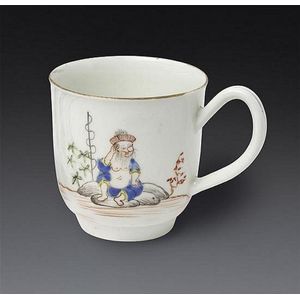Famille Rose Landscape Beaker
You must be a subscriber, and be logged in to view price and dealer details.
Subscribe Now to view actual auction price for this item
When you subscribe, you have the option of setting the currency in which to display prices to $Au, $US, $NZ or Stg.
- Lappet Decoration - In the context of furniture, ceramics, and oriental wares, the word "lappet" refers to a decorative motif that consists of a repeated pattern of stylized or abstracted "lappets."
A lappet in this context is a decorative element that resembles a small, hanging flap of cloth or fabric, but rather are stylized patterns that resemble the shapes and folds of lappets. They can be found on a wide range of objects, including furniture, vases, bowls, and plates.
Lappet decoration can take many different forms, but typically consists of a series of semi-circular or pointed shapes that are repeated in a continuous pattern. The shapes may be simple or highly ornate and may be arranged in a regular or irregular pattern. The design may also include other decorative elements, such as floral or foliate motifs.
Lappet decoration is often associated with Asian design traditions, and can be found on a wide range of objects from these regions, including Chinese porcelain, where lappet decoration is often used as a symbol of abundance and prosperity, and is believed to have protective and auspicious qualities. - Qing Dynasty - The Qing Dynasty was the last imperial dynasty of China, ruling from 1644 to 1912. It was established by the Manchu people, who originated from the northeastern region of China. The Qing Dynasty was preceded by the Ming Dynasty and followed by the Republic of China.
- Ming Dynasty - The Ming Dynasty was a ruling dynasty of China from 1368 to 1644. It succeeded the Yuan Dynasty and preceded the Qing Dynasty. The Ming Dynasty was established by Zhu Yuanzhang, a former Buddhist monk who became a rebel leader and eventually overthrew the Mongol Yuan Dynasty. During the Ming Dynasty, China experienced a period of relative stability and prosperity. The government was centralized and bureaucratic, with the emperor at the top of the hierarchy. The Ming Dynasty is known for its cultural achievements, including the development of porcelain, the invention of movable type printing, and the construction of the Great Wall of China.
This item has been included into following indexes:
- Chinese ceramics, famille decoration - famille rose, fencai, yangcai, other 1,370
-
Chinese ceramics, item type
- figurines 1,568
- mugs and beakers 95
Visually similar items

A First period Worcester ?Cracked Ice? Ground pattern tankard, circa 1765. A First period Worcester 'Cracked Ice' Ground pattern tankard, circa 1765 of bell shape with loop handle, painted in underglaze blue and depicting an Oriental figure seated in lands

A First period Worcester coffee cup, circa 1754 - 56 of plain form with a grooved handle, painted in colours with figures in landscape, a fisherman seated by the water, a lady standing gazing and a young man holding a mask. 6 cm high. Provenance: Albert Am

Spode blue and white stone china potty, Grasshopper' pattern, printed mark to base. Height 14 cm Diameter 22 cm

A Moorcroft 'Rosehip' pattern mug, of waisted form with a squared handle, and decorated with a tubelined and handpainted rosehip sprig in olive green and red upon a cream ground; with backstamp underside and artist initials. Height 9 cm.
